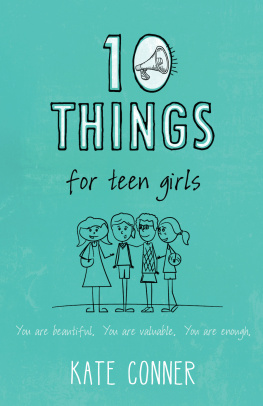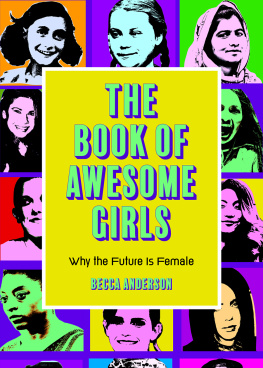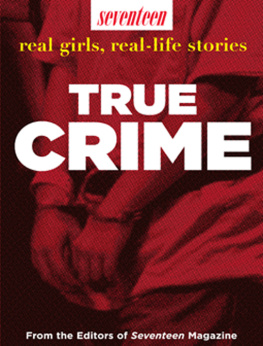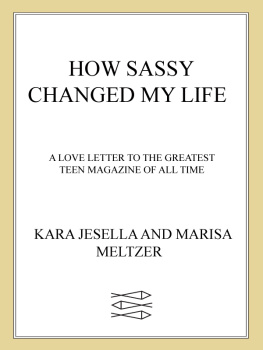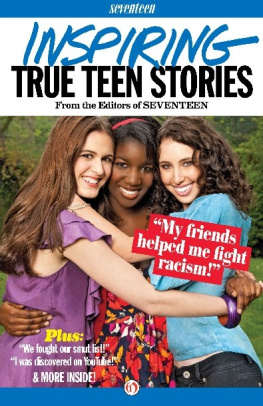First published in 2010 by Left Coast Press, Inc.
Published 2016 by Routledge
2 Park Square, Milton Park, Abingdon, Oxon OX14 4RN 711
Third Avenue, New York, NY 10017, USA
Routledge is an imprint of the Taylor & Francis Group, an informa business
Copyright 2010 Taylor & Francis
All rights reserved. No part of this book may be reprinted or reproduced or utilised in any form or by any electronic, mechanical, or other means, now known or hereafter invented, including photocopying and recording, or in any information storage or retrieval system, without permission in writing from the publishers.
Notice:
Product or corporate names may be trademarks or registered trademarks, and are used only for identification and explanation without intent to infringe.
Library of Congress Cataloguing-in-Publication Data
Massoni, Kelley.
Fashioning teenagers : a cultural history of Seventeen magazine / Kelley Massoni.
p. cm.
Includes bibliographical references and index.
ISBN 978-1-59874-503-0 (hardcover : alk. paper) -- ISBN 978-1-59874-504-7 (pbk. : alk. paper)
1. Mass media and teenagers. 2. Seventeen--History. 3. Periodicals--Publishing. 4. Teenage girls--United States--Attitudes. 5. United States--Civilization--20th century. I. Title.
HQ799.2.M35M372 2010
302.232408352097309045--dc22
2010006396
ISBN 978-1-59874-503-0hardcover
ISBN 978-1-59874-504-7paperback
I n the 1940s, two contemporary themes appeared in the American media and the American consciousness: the teenager and the teen magazine. These themes crystallized in the creation of Seventeen, the first teen magazine. The story of Seventeens origins is a fascinating one, with the twists and turns of a novel. It features powerful personalities engaged in professional alliances, personal disputes, and private betrayals. It also provides a genealogy for understanding our modern version of youth culture and the teen girl ideal.
Seventeen originated in the mind of its founding editor-in-chief, Helen Valentinewho referred to the magazine as her baby. Valentine envisioned a service and fashion magazine for high school girls, an idea that she sold to publisher Walter Annenberg in 1944. As the first teen magazine, Seventeen developed and modeled the emerging teen girl ideal in its editorial pages, promotional materials, and advertisements. In the earliest issues, Seventeens editorial staff crafted a magazine that balanced fashion and beauty with articles on work and citizenship, writing for a teen readership that Valentine described as whole human beings. But Seventeen also marketed teen girlsas consumersto business, often through their prototype, Teena. Advertisers responded by selling to Seventeens readership not just products but a consumer role and a feminine ideal.
Seventeens representation of the teen girl ideal shifted dramatically between the magazines birth and fifth birthday. Over time, consumerist content increased as Seventeen moved away from Valentines progressive model of service and citizenship and toward the more traditional model of fashion, romance, and homemaking. The Teena ideal of the editorial pageseditorial Teenabecame more reflective of promotional Teenathe Teena being sold in the magazines promotional materials and by its advertisers.
In this book, I explore the social and cultural forces that exerted pressure on Valentine and Seventeen from the beginning, including the end of the war; the economic structure of the magazine industry; reader preferences; and power relations at the magazine. By Seventeens sixth birthday, Valentine was no longer editor-in-chief, and the magazine and its teen girl ideal had departed from their wartime citizen-oriented roots and entered a domesticated (and highly gendered) consumer future.
Researching Seventeen Magazine
I used an extended case study design to investigate Seventeens birth and early development as a teen magazine. Drawing on archival materials, historical sources, oral histories, interviews, and the magazines text, images, and advertisements, I examined Seventeen as a magazine, a business, a workplace, and a cultural phenomenon during its first six years, paying particular attention to two periods: September 1944 to September 1945 (the World War II period) and September 1949 to September 1950 (the postwar period).
I chose this periodization for several reasons: it parallels the magazines own milestone commemorative dates (birthdays); it encompasses the tenure of first editor-in-chief Helen Valentine and the aftermath of her dismissal; archival documents are available for these years at Seventeen; and it spans a short but significant historical period. This case study approach includes historical research (using both primary and secondary sources), biographical interviews with former Seventeen staffers and their family members, and textual analysis of the magazine issues from cover to cover.
I drew on relevant historical documents, including newspapers, magazines, industry publications such as The Writers Market, and government publications such as the Magazine War Guide. I also drew on secondary sources, such as academic monographs and books about the historical periods covered and the magazine industry in the twentieth and twenty-first centuries.
I gathered information on Helen Valentine from a variety of sources, including her oral history, taken by the American Jewish Committee in 1982; my interviews with her daughter, Barbara Valentine Hertz, and granddaughter, Valentine Hertz Kass; and personal correspondence made available to me by the Valentine family. For information on Walter Annenberg, I used two biographies written about him, one by John Cooney and the other by Christopher Ogden, the latter having been allowed access to Annenberg and his papers, as well as news media reports about Annenbergs life (and death).
I also drew on the experiences of former Seventeen staffers, including Estelle Ellis, the magazines first promotion director, who knew and worked with Helen Valentine and Walter Annenberg. I conducted four interviews and had other personal correspondence with Ellis, and also used her published oral history, taken by the American Jewish Committee in 1990. I conducted telephone interviews with two former Seventeen editorial assistants, Alberta Eiseman and Ingrid Loewenstein Sladkus. Although Alice Thompson, who played an important role in Helen Valentines life and career, died in 1985, I tried to gather as much information as I could about her, drawing on newspaper and magazine accounts of her career and interviews with colleagues. For my textual analysis of the magazines content, I closely read every page of each sampled issue of



